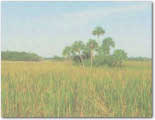Relationships Between Inshore Nursery Habitats of the Pink Shrimp, Penaeus duorarum, and the Offshore Tortugas and Sanibel Fisheries
South Florida's seagrass and mangrove dominated estuaries serve prominently as nursery habitats for the pink shrimp, Penaeus duorarum, and support two offshore fisheries. The Tortugas fishery is the larger of the two and is the largest commercial fishery in Florida, with landings of approximately 9 million pounds annually. The Sanibel fishery is smaller, with a harvest averaging about 4 percent of the Tortugas Grounds. During the middle to late 1980's, a sharp decline in Tortugas landings occurred roughly coincident with seagrass die-off and the subsequent onset of extensive and persistent algal blooms in Florida Bay. These events focused increased attention on the interdependence of south Florida's estuaries and the productivity of Florida's offshore shrimping grounds and the role that the pink shrimp might play in restoration related research activities for Florida Bay.
Questions regarding the relative importance of inshore nursery areas in south Florida and the timing of movements between inshore nurseries and offshore fishing grounds are considered critical for evaluating the cause of recent declines in Florida's pink shrimp fishery and for establishing the pink shrimp as a performance measure for evaluating restoration alternatives for Florida Bay. In this project, we propose to use natural stable C, N, and S isotope ratios to link inshore pink shrimp stocks with the offshore Tortugas and Sanibel fisheries.
Our objectives are to:

Investigator: Michael B. Robblee
Summary
The objectives of this study are to use natural stable C, N, and S isotope ratios to link inshore pink shrimp stocks with the offshore Tortugas and Sanibel fisheries.
Publications
Abstracts:
Flyer:
This page is: http://sofia.usgs.gov/projects/pink_shrimp/index.html
Comments and suggestions? Contact: Heather Henkel - Webmaster
Last updated: 16 January, 2004 @ 04:30 PM (TJE)
